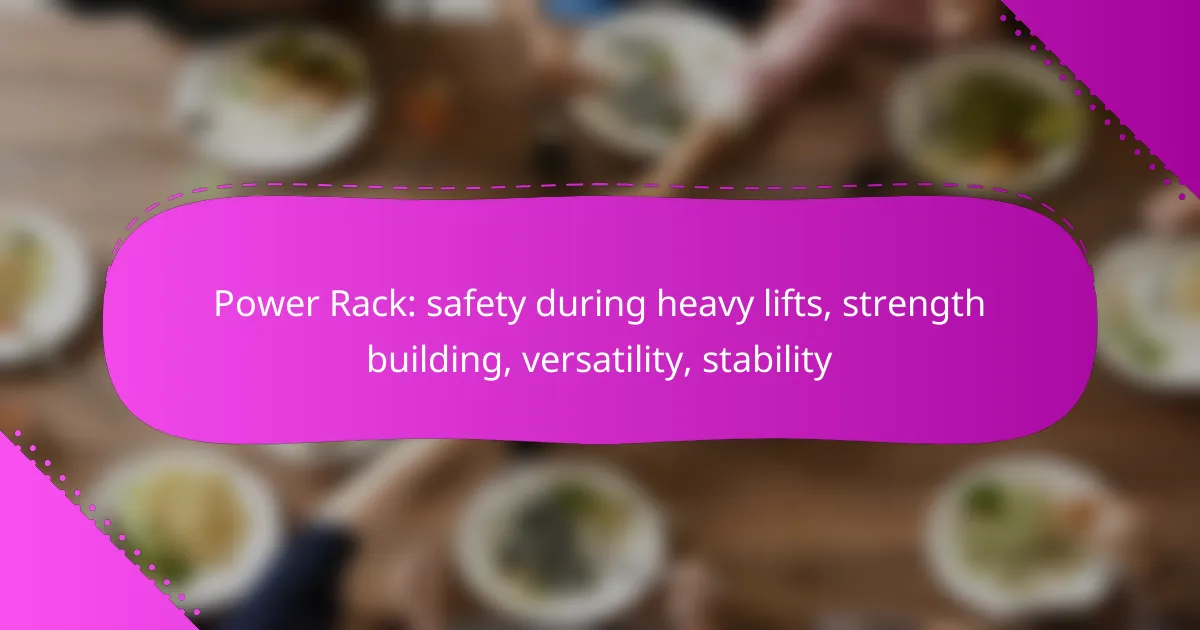A power rack is an essential tool for anyone serious about strength training, providing a safe and stable environment for heavy lifts. Its versatile design allows for a wide range of exercises, ensuring users can effectively build strength while minimizing the risk of injury. With features that enhance stability and support, a power rack is ideal for both beginners and advanced lifters alike.

How can a power rack enhance safety during heavy lifts?
A power rack significantly enhances safety during heavy lifts by providing a secure environment for weight training. Its design includes features that help prevent accidents, allowing users to focus on their strength-building goals without the constant worry of injury.
Integrated safety bars
Integrated safety bars are a crucial feature of power racks, designed to catch the barbell if it slips or if the lifter fails to complete a lift. These bars can be set at various heights to accommodate different exercises and user preferences. This feature allows for safer solo workouts, as it minimizes the risk of injury from dropped weights.
Adjustable height settings
Adjustable height settings on a power rack enable users to customize the position of the safety bars and the barbell itself. This flexibility is essential for accommodating various exercises, such as squats, bench presses, and overhead lifts. By adjusting the height, lifters can ensure that the bar is at a comfortable level, reducing strain and enhancing safety.
Spotter arms for added security
Spotter arms are additional safety features that provide extra support during heavy lifts. These arms act as a backup in case the lifter cannot complete a repetition, allowing the barbell to rest safely without hitting the ground. This feature is particularly beneficial for those lifting heavy weights alone, as it provides peace of mind and encourages users to push their limits safely.
Stability during lifts
The stability of a power rack is vital for safe lifting, as it minimizes movement while performing exercises. A well-constructed power rack is typically made from heavy-duty steel, ensuring it remains stable even under significant weight. Users should ensure that the rack is properly anchored and set up on a level surface to maximize stability and safety during their workouts.

What are the benefits of using a power rack for strength building?
A power rack offers numerous benefits for strength building, including safety during heavy lifts, versatility for various exercises, and the ability to improve lifting technique. It allows users to perform a wide range of movements while minimizing the risk of injury.
Supports various exercises
A power rack is designed to accommodate a multitude of exercises, making it a versatile addition to any gym. Users can perform squats, bench presses, deadlifts, and overhead presses, among others, all within the safety of the rack. This versatility allows for a comprehensive strength training routine.
Additionally, many power racks come with attachments such as pull-up bars and dip stations, further expanding exercise options. This adaptability makes it easier to target different muscle groups effectively.
Encourages progressive overload
Progressive overload is essential for muscle growth and strength development, and a power rack facilitates this process. Users can gradually increase weights with safety, as the rack provides secure support for heavy lifts. This feature encourages consistent strength gains over time.
To effectively implement progressive overload, consider increasing weights by small increments, typically between 2.5 to 5 kg, depending on the exercise. This gradual approach helps prevent injury while promoting continuous improvement.
Improves lifting technique
Using a power rack can significantly enhance lifting technique by allowing users to focus on form without the fear of dropping weights. The safety bars can catch the barbell if the lift is unsuccessful, providing confidence to push limits. This safety net encourages proper technique and reduces the risk of injury.
To maximize technique improvement, consider using lighter weights initially to master form before progressing to heavier loads. Regularly reviewing your form, possibly with the help of a trainer, can also be beneficial in ensuring effective and safe lifting practices.

How versatile is a power rack for different workouts?
A power rack is highly versatile, accommodating a wide range of workouts from strength training to conditioning exercises. Its design allows for various attachments and modifications, making it suitable for different fitness levels and goals.
Compatible with attachments
Power racks can be equipped with various attachments such as pull-up bars, dip bars, and resistance bands. These attachments enhance the functionality of the rack, allowing users to perform a broader range of exercises, including chin-ups, dips, and banded lifts.
When selecting attachments, ensure they are compatible with your specific power rack model. This compatibility maximizes the versatility of your workouts and can lead to more effective strength training routines.
Multi-use for strength and conditioning
A power rack is not just for heavy lifts; it can also be used for conditioning workouts. Exercises like squats, bench presses, and deadlifts can be performed alongside functional movements such as box jumps and kettlebell swings, creating a comprehensive training regimen.
Incorporating both strength and conditioning exercises in your routine can improve overall fitness. Aim for a balanced approach, dedicating time to both strength-building and cardiovascular conditioning to achieve optimal results.
Adaptable for various fitness levels
Power racks are suitable for beginners to advanced lifters, as they can be adjusted to accommodate different heights and weights. Beginners can start with lighter weights and gradually increase resistance as they build strength and confidence.
Consider using safety features like adjustable spotter arms or safety pins, which allow users to lift heavier weights safely. This adaptability ensures that individuals at any fitness level can benefit from using a power rack effectively.

What factors contribute to the stability of a power rack?
The stability of a power rack is primarily influenced by its weight distribution, material quality, and anchoring options. These factors ensure that the rack remains secure during heavy lifts, minimizing the risk of tipping or wobbling.
Weight distribution design
A well-designed power rack features a low center of gravity, which enhances stability during lifts. The placement of weight plates and the overall structure should distribute weight evenly to prevent tipping. Look for racks that allow for adjustable weight placement to optimize balance.
Consider racks with wider bases, as they provide a more stable foundation. A wider stance can significantly reduce the likelihood of movement during heavy lifts, making it safer for users.
Material quality and construction
The stability of a power rack is heavily dependent on the materials used in its construction. High-quality steel with a thick gauge is preferable, as it can withstand heavy loads without bending or breaking. Always check for certifications or standards that indicate durability.
Welded joints and reinforced corners contribute to a rack’s overall strength. Avoid racks with flimsy components, as they may compromise safety during intense workouts.
Floor anchoring options
Anchoring a power rack to the floor can significantly enhance its stability, especially in home gyms or commercial settings. Many racks come with pre-drilled holes for bolting them down, which is advisable for heavy lifters.
When choosing a power rack, consider whether it includes anchoring options. If not, you may need to purchase additional hardware to secure it properly. Ensure that the floor surface can accommodate anchors, as concrete is typically the best choice for stability.

How to choose the right power rack for home gyms in Australia?
Choosing the right power rack for home gyms in Australia involves considering your space, lifting needs, and budget. A suitable power rack enhances safety during heavy lifts, supports strength building, and offers versatility for various exercises.
Space considerations
When selecting a power rack, assess the available space in your home gym. Measure the height, width, and depth of the area to ensure the rack fits comfortably without obstructing movement. Typically, a power rack requires a footprint of around 1.2m x 1.2m, but larger models may need more room.
Consider the ceiling height as well, especially if you plan to perform overhead lifts. A standard power rack height ranges from 2m to 2.3m, so ensure your ceiling can accommodate this plus any additional clearance for exercises like pull-ups.
Lastly, factor in the space for additional equipment and your own movement. A clear area around the rack is essential for safety and ease of use, so aim for at least 1m of clearance on all sides.
